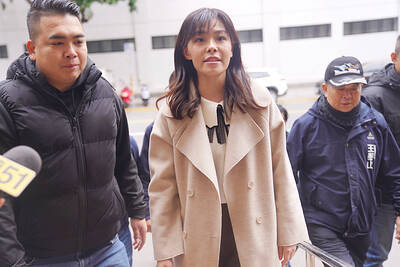China appears to be deploying weapons systems on all seven of the reefs it has reclaimed in the South China Sea, according to photographs released by a Washington-based think tank.
The Asia Maritime Transparency Initiative said it began tracking in June and July the construction of identical hexagon-shaped structures to house the weapons on Fiery Cross Reef (Yongshu Reef, 永暑島), Mischief Reef (Meiji Reef, 美濟礁) and Subi Reef (Jhubi Reef, 渚碧礁), where China has already completed military grade airstrips and installed radar.
“It now seems that these structures are an evolution of point-defense fortifications already constructed at China’s smaller facilities on Gaven [Nansyun, 南薰礁], Hughes [東門礁], Johnson [South] [Chigua Reef, 赤瓜礁] and Cuarteron [Huayang Reef, 華陽礁] reefs,” the unit of the Center for Strategic and International Studies said on its Web site.

Photo: AFP / CSIS Asia Maritime Transparency Initiative / DigitalGlobe
The installations call into question a pledge made by Chinese President Xi Jinping (習近平) not to militarize the disputed islands in the South China Sea, a US$5 trillion-a-year shipping route that the US has patrolled largely unchallenged since World War II.
China’s claims to more than 80 percent of the waters were dismissed by an international tribunal in July. Beijing said it would ignore the ruling.
US president-elect Donald Trump has cited what he said was China’s effort to build a “massive fortress” in the South China Sea as one reason for taking a more confrontational approach to relations.
He listed the project in a Fox News interview, while defending his decision to accept a telephone call from President Tsai Ing-wen (蔡英文), calling into question the US’ “one China” policy.
“I don’t know why we have to be bound by a ‘one China’ policy unless we make a deal with China having to do with other things, including trade,” Trump said in the interview broadcast on Sunday.
The think tank said that anti-aircraft guns appear to have been installed on China’s four smaller reefs. Although they cannot be definitively identified, they were likely to be close-in weapons systems (CIWS) whose function was to detect and destroy incoming missiles and enemy aircraft, the group said.
“These gun and probable CIWS emplacements show that Beijing is serious about defense of its artificial islands in case of an armed contingency in the South China Sea,” it wrote. “Among other things, they would be the last line of defense against cruise missiles launched by the United States or others against these soon-to-be-operational air bases.”

The US government has signed defense cooperation agreements with Japan and the Philippines to boost the deterrence capabilities of countries in the first island chain, a report by the National Security Bureau (NSB) showed. The main countries on the first island chain include the two nations and Taiwan. The bureau is to present the report at a meeting of the legislature’s Foreign Affairs and National Defense Committee tomorrow. The US military has deployed Typhon missile systems to Japan’s Yamaguchi Prefecture and Zambales province in the Philippines during their joint military exercises. It has also installed NMESIS anti-ship systems in Japan’s Okinawa

‘WIN-WIN’: The Philippines, and central and eastern European countries are important potential drone cooperation partners, Minister of Foreign Affairs Lin Chia-lung said Minister of Foreign Affairs Lin Chia-lung (林佳龍) in an interview published yesterday confirmed that there are joint ventures between Taiwan and Poland in the drone industry. Lin made the remark in an exclusive interview with the Chinese-language Liberty Times (the Taipei Times’ sister paper). The government-backed Taiwan Excellence Drone International Business Opportunities Alliance and the Polish Chamber of Unmanned Systems on Wednesday last week signed a memorandum of understanding in Poland to develop a “non-China” supply chain for drones and work together on key technologies. Asked if Taiwan prioritized Poland among central and eastern European countries in drone collaboration, Lin

ON ALERT: Taiwan’s partners would issue warnings if China attempted to use Interpol to target Taiwanese, and the global body has mechanisms to prevent it, an official said China has stationed two to four people specializing in Taiwan affairs at its embassies in several democratic countries to monitor and harass Taiwanese, actions that the host nations would not tolerate, National Security Bureau (NSB) Director-General Tsai Ming-yen (蔡明彥) said yesterday. Tsai made the comments at a meeting of the legislature’s Foreign Affairs and National Defense Committee, which asked him and Minister of National Defense Wellington Koo (顧立雄) to report on potential conflicts in the Taiwan Strait and military preparedness. Democratic Progressive Party (DPP) Legislator Michelle Lin (林楚茵) expressed concern that Beijing has posted personnel from China’s Taiwan Affairs Office to its

BACK TO WORK? Prosecutors said they are considering filing an appeal, while the Hsinchu City Government said it has applied for Ann Kao’s reinstatement as mayor The High Court yesterday found suspended Hsinchu mayor Ann Kao (高虹安) not guilty of embezzling assistant fees, reducing her sentence to six months in prison commutable to a fine from seven years and four months. The verdict acquitted Kao of the corruption charge, but found her guilty of causing a public official to commit document forgery. The High Prosecutors’ Office said it is reviewing the ruling and considering whether to file an appeal. The Taipei District Court in July last year sentenced Kao to seven years and four months in prison, along with a four-year deprivation of civil rights, for contravening the Anti-Corruption